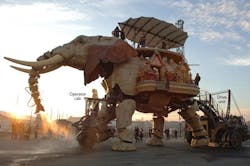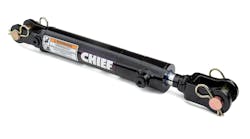Gigantic. Majestic. Futuristic. Even scary. Those are just some of the words that describe the Great Elephant at Machines of the Isle in Nantes, France, birthplace of science fiction pioneer Jules Verne.
Situated in warehouses at the former shipyards in Nantes, the Machines of the Isle was created by two artists to illustrate a travel-through-time world at the crossroads of the imaginary worlds of Jules Verne and the mechanical universe of Leonardo da Vinci.
The Great Elaphant stands 12-m (39 ft) high and holds up to 49 passengers. It walks at speeds to 3 km/hr, roars, moves its legs, ears, tail and eyes, and sprays water and blows air from its realistic-moving trunk. Most of this action comes courtesy of electrohydraulics.
The Great Elephant holds 2,000 l (530 gal) of hydraulic oil, and with full movement pumps up to 600 lpm (160 gpm) of hydraulic fluid from two 130 cc (8 in.3) variable-displacement axial-piston pumps. The pumps drive a pair of 60 cc (3.7 in.3) variable-displacement bent-axis piston motors located in a drive module behind the elephant. In addition to the hydraulic motors, 44 hydraulic cylinders and 6 pneumatic cylinders create the motion that brings lifelike action to the star of the attraction. Fifty-one proportional hydraulic valves with integrated electronics and fault monitoring control most of the action.
The Great Elephant goes on 30-min excursions, and if viewing the grounds from a terrace atop the elephant ins't your thing, you can stroll inside to take in the action from an indoor lounge or any of several balconies. the driver probaly has the least impressive view because the cab is a few feet above the ground under the elephant's head. The operations are executed through jouysticks, while other walking alongside have access to additional controls, features, and, of course safety functions.
Click here to visit the web page for Machines of the Isle, or click here to watch a video of the elephant in action.
Here's another video that's a bit long, but it does a better job of showing the functions and workings of this truly impressive machine.


